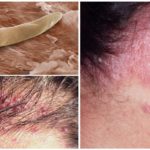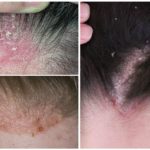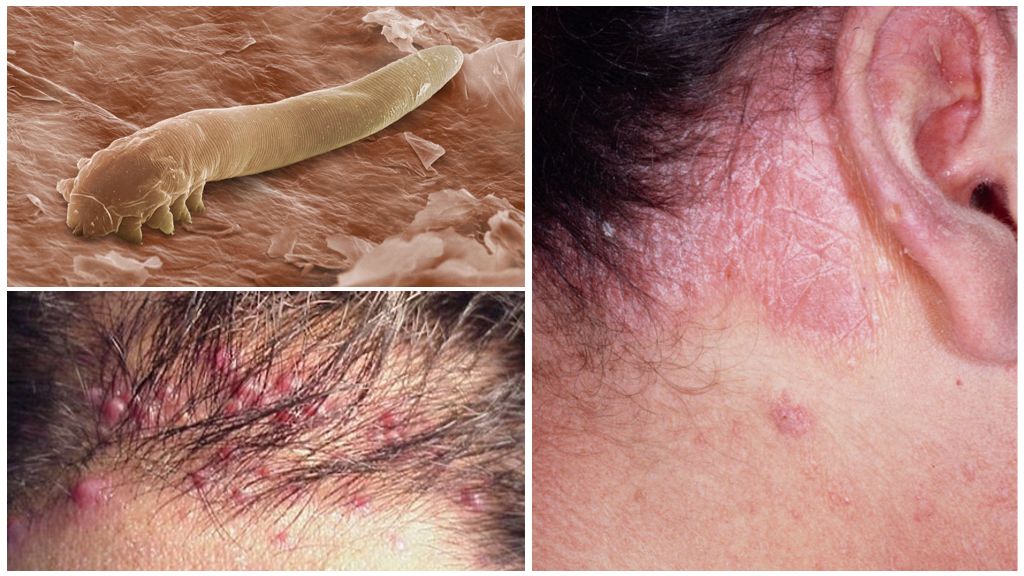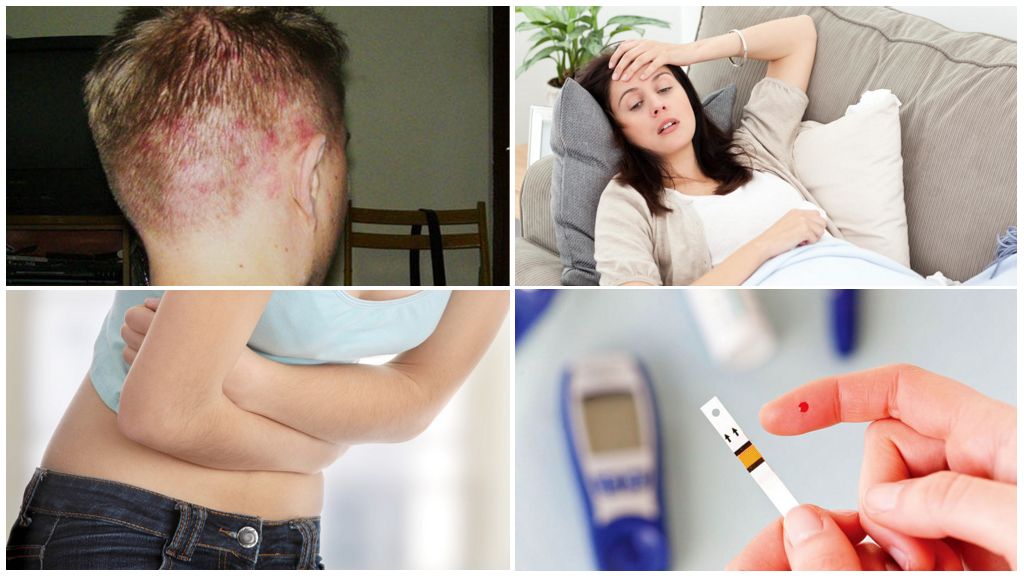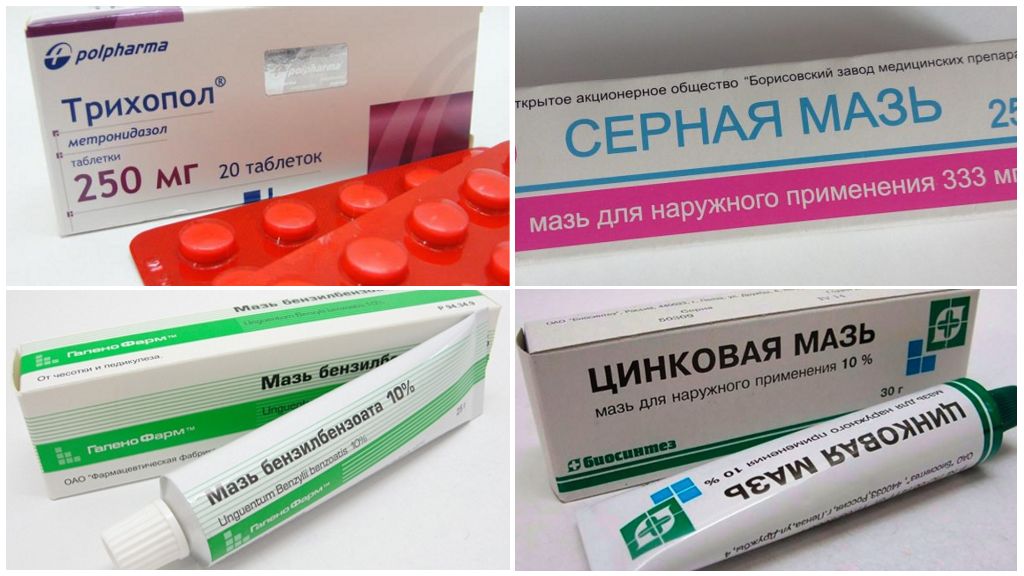Symptoms and treatment of hair mite in humans
Content
- Hair mite on the scalp
- Causes of scalp demodicosis
- Demodecosis of the scalp
- Treatment of demodicosis of the scalp
Demodecosis is a disease that was provoked by a tick in the head. The parasite has the same name - Demodex and is a worm-like specimen with a developed microscopic jaw to bite and claws for effective anchoring.The disease is a serious problem for a person and requires immediate treatment. The sooner measures are taken to correct the problem, the easier it will be to recover.
How is the disease manifested
Demodecosis can be detected independently only in the phase when ticks begin active reproduction. Their processes of vital activity will bring a person serious discomfort. The peak activity of ticks falls on the period of emotional overstrain, stressful situations or other factors causing a decrease in the body's defenses.
Important!
The treatment of a tick in the head, started before the parasite begins its active activity, will proceed easier and will give a positive result faster.
Demodecosis begins rapidly and is characterized by a sharp deterioration in the human condition. That is why you should know the main symptoms of a tick on the head in the hair:
- Itching, burning, feeling of tightness of the skin. The main and very first sign of the disease.
- Dryness of the skin, resulting in dandruff, flaky skin.
- Redness in places affected by ticks that do not pass.
- Rash on scalp.It is manifested by the appearance of red nodules (papules).
- Consolidation of the epidermis.
- You can see the spider veins on the skin.
At the initial stage, self-diagnosing a tick on the head is rather problematic. Symptoms are very similar to the manifestation of dandruff, therefore instead of competent therapy only advertised shampoos for seborrhea are used.
Hair mite in humans continues its development, highlighting an increasing number of waste products. In the future, they will provoke a response of the body. If the disease is ignored, then in the place of the greatest accumulation of mites, the hair will start to fall out, and the skin will thicken.
On a note!
In most cases, the Demodex mite affects the head, but it can also be detected on the eyebrows, eyelashes, and even behind the ears.
Diagnostic methods
Understand that bit a tick in the head and reliably confirm the diagnosis only a specialist. To do this, contact your dermatologist, cosmetologist or trichologist. The specialist will conduct a visual inspection, interview the patient for symptoms and prescribe laboratory tests.
To detect ticks can use:
- Scraping the epidermis from the affected area. This analysis will determine the presence of a tick and assess the extent of the lesion.
- Analysis of sebaceous gland secretions. During material collection, the integrity of the skin is damaged.
- Superficial biopsy. Allows you to assess the degree of damage.
- Skin biopsy with histology. It is performed on a small area of skin with the extraction of the sebaceous glands.
- Hair removal for follicle examination. With this study, a specialist can find a tick in the hair on the head, eyelashes and eyebrows. The only method that evaluates follicle damage.
On a note!
A survey on bioresonance equipment will help determine the depth of the sitting of the parasite. After the diagnosis and assessment of the degree of neglect of the disease, the doctor will be able to prescribe treatment.
Causes of demodicosis
The reason why there was a subcutaneous mite on the head, can be both internal and external factors.
Internal:
- reduced immunity after illness;
- general weakness of the body, which is the result of a lack of vitamins or transferreddiseases;
- chronic viral diseases, including tuberculosis, hepatitis, HIV, toxoplasmosis;
- damage by worms that inhibit the work of the immune system, aggravate the effects of other diseases;
- various autoimmune diseases also contribute to a decrease in defenses;
- diseases of the gastrointestinal tract - due to increased growth of pathogens and bacteria;
- adherence to existing skin diseases;
- malignant neoplasms;
- diabetes.
On a note!
Often, the subcutaneous mite activates its activity in pregnant women.
External factors can also provoke the development of the disease:
- high temperatures, then for those who like to take hot baths, visit baths and saunas;
- bad habits: alcohol, smoking;
- unhealthy diet: an abundance of fatty, fried and smoked food, excessive consumption of sweets;
- environmental pollution.
In a healthy person who leads an active lifestyle, plays sports, monitors his health and the quality of food, the chances of being affected by a tick are much less.
Consequences of ignoring the disease
If a hair mite is not detected in people in time, and treatment is not prescribed, then demodecosis will develop into a more dangerous form.
Ticks in the head can cause such unpleasant phenomena:
- Frequent conjunctivitis.
- Decreased visual acuity. This process is reversible after the elimination of the cause.
- The appearance of whitish plaque on the eyelids and eyelashes.
- Regular appearance of barley on the eyes.
Interesting!
In a healthy person, the presence of Demodex mite does not cause any inconvenience and is asymptomatic.
Below is a photo of a tick in the head, which was not stopped in time and managed to spread widely over the skin surface.
Treatment rules
Treat subcutaneous mites in several ways at once. Only an integrated approach will effectively and quickly get rid of the disease.
Antidemodecosis therapy includes:
- Destruction of the tick with special preparations.
- Cleansing the body, excretion of toxins.
- Strengthening immunity.
At the first stage, the specialist directs forces to the extermination of the tick itself. To do this, use:
- Ointment Benzyl benzoate.An aggressive agent that causes skin irritation, but very effectively fights against the subcutaneous mite at any stage of its spread.
- Sulfuric ointment. It should be applied to the affected skin daily. A prerequisite is the daily replacement of bed linen for clean.
- Zinc ointment. Dries the skin, prevents the spread of fungus, destroys the tick.
- Clotrimazole. An effective remedy that is often used in various fungal diseases and against parasites.
- Streptocide. The drug has lost relevance, as there were more powerful. But it is actively used as an additional therapy, accelerating the healing of the skin.
- Trichopol. Active against parasites of various species. It affects the DNA of the tick and destroys it.
On a note!
If the tick activity is characterized by the appearance of a large number of pustules, refer to antibiotic ointments. These are Tetracycline, Levomitsetin, Erythromycin.
Additionally, it is also prescribed angistamines. They help reduce tick manifestations and reduce the body's sensitivity.For these purposes, it is recommended to use:
- Suprastin.
- Zyrtec
- Erius.
- Eden.
- Tavegil.
Treatment of ringworm can also be carried out in the conditions of medical institutions with the help of physical procedures:
- Laser removal. With the help of a special device is the destruction of the parasite.
- Antiseptic Stimulator Road.
On a note!
Strengthen therapy will help special shampoos against demodicosis.
To increase the protective functions of the body, the doctor may prescribe a multivitamin complex, B vitamins, vitamin C, iron, calcium, zinc, folic acid.
Special attention is paid to the restoration of the psycho-emotional state of a person. Valerian, Persen, and other drugs of similar action can be prescribed as sedatives.
At the time of treatment it is necessary to exclude spicy, fatty, fried and smoked food, reduce flour and sweet.
Folk methods
Well help simple folk remedies. But they are recommended to be applied only after consulting with a specialist. Otherwise, therapy may be ineffective and even harm.
For these purposes, use:
- Kerosene. They lubricate the scalp.
- Birch tar.It will also help get rid of the tick, if you lubricate the head with the agent.
- Hydrogen peroxide. She needs to treat the affected areas 2-3 times a day.
- Masks on the basis of sunflower oil. The use of such a method often becomes the reason why a large tick emerged from the head after treatment. The dense texture of the material blocks the access of oxygen to parasites, and they get out.
- Garlic compresses. Pereteret garlic or skip through a press and apply on the scalp. Wrap in cellophane and incubate for 30 minutes. After that, wash your hair with a special shampoo.
Important!
Increased attention during the fight against ticks should be paid to hygiene. Disinfection of bed linen and towels is necessary. Replace feather blankets and pillows with synthetic ones.
During the use of folk remedies should closely monitor the condition of your body. If you experience any discomfort, itching or burning, immediately stop the procedure and rinse the affected area with running water.

